Best Trekking Trails in Annapurna Region
The region extends to Kaski, Lamjung, Manang and Mustang districts. The large parts of this area falls on the rain shadow.
The region extends to Kaski, Lamjung, Manang and Mustang districts. The large parts of this area falls on the rain shadow.
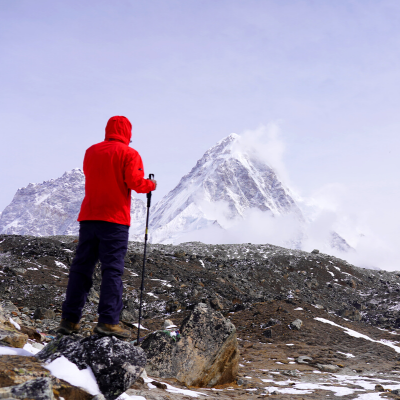
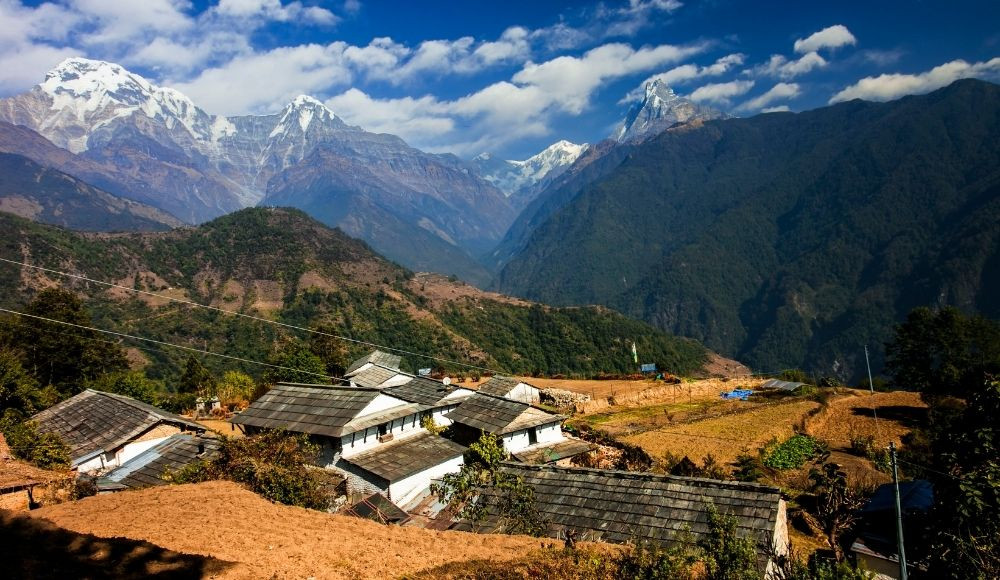
Annapurna region is one of the diverse areas to explore in Nepal. It offers multiple trekking trails to the adventure trekkers. Each trial offers a unique taste to explore. The area lies within the 5 districts of Gandaki province of Nepal. It also includes some of the restricted areas in Manang and Mustang districts, which require special permits from Nepal governments with specified rules.
One of the best majestic regions of the Nepalese Himalayas is widely known as Annapurna Region. This region was converted as a Conservation area in 1986 having an area of 7600 sq. km. It includes several ranges of mountains including Annapurna, Dhaulagiri, Manaslu, Machhapuchchhre, and many more. The region extends to Kaski, Lamjung, Manang and Mustang districts. The large parts of this area falls on the rain shadow. So, they are drier than the southern slopes of mountains. Hence, trekking is also available during monsoon.
The major attractions are crossing uneven terrain, big Annapurna mountains, staying in ethnic villages, and hiking the Hindu and Buddhist holy trails. This region also offers the sociocultural diversity of the Gurung community of Nepal. Culture and language exchange with the locals make the trip more remarkable. The trek is popular due to the close up of tall peaks in Annapurna sanctuary.
Spectacular section of the Himalayas provides a glimpse of the beauty of Annapurna Region. Visitors cannot miss sweeping glaciers, forests including Rhododendron and untamed wildlife, natural paradise with diverse flora and fauna including multi socio-cultural society.
|
Area |
7629 Sq.km. |
|
Elevation |
760 m (low) to 8167 metres (high) |
|
Starting point |
Pokhara, Besisahar, Jomsom |
|
Ending point |
Pokhara |
|
Buffer zone population |
7745 |
|
Major Ethnic Group |
Gurung and Magar |
|
Major religion |
Hindu and Buddhism |
|
Prime Rivers |
Kali Gandaki, Marshyangdi |
|
Major Peaks |
Annapurna I (8,091 m) Machhapuchhre (6993 m) Dhaulagiri I (8167 m). |
|
Major Sites |
Muktinath, Deepest gorge Kali Gandaki valley, Thorong La pass (5416 m) |
The sanctuary covers a variety of landscapes ranging from rich valleys to the high altitude desert region of Mustang. The local communities found here are Mongolians namely Gurung, Magar and Thakali. Their cultures and traditions highly influence this area. They settle on the high elevation. Conversely, Brahmin and Chhetri reside on the lower elevation. Another feature of this area is Easily accessible guest houses and hotels with hygienic food. The accommodation facilities here are very good.
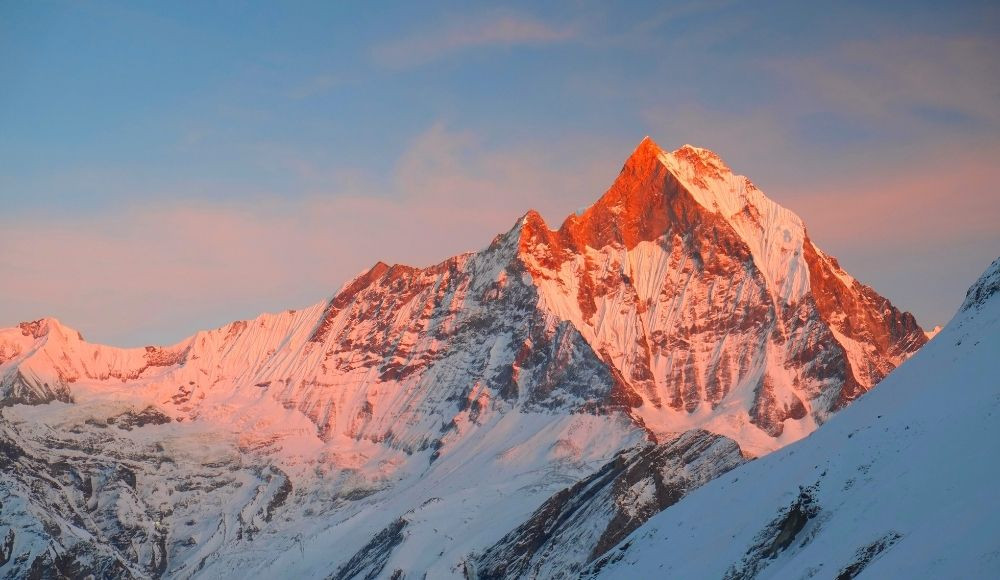
This zone is a widely visited and most famous trekking destination after Everest for domestic and international tourists. Approximately, two thirds of hikers and trekkers visiting Nepal travel this region. They have a wonderful and breathtaking memory of this territory every year. Trekkers must need an ACAP permit and Trekkers Information Management System (TIMS) to explore this route.
|
List of Best Trekking Trails in Annapurna |
|
If you are looking for a truly exciting trekking adventure in west Nepal, Annapurna Base Camp Trek can be the right trek for you. This awesome trail walking adventure takes you to the base of a marvellous mountain sanctuary in Annapurna.
Annapurna base camp trek takes you to the foothills of the amazing Annapurna Mountains and offers an overwhelming Himalayan trekking experience. As a high altitude trekking adventure, it involves the views of magnificent views of mountains. While we aim for the Annapurna Base Camp as our ultimate destination of the trek, we will also enjoy equally the surroundings of the trail that we walkthrough. The trail at the sideways of the Modi River valley has beautiful natural surroundings that make our walking more amazing and wonderful.
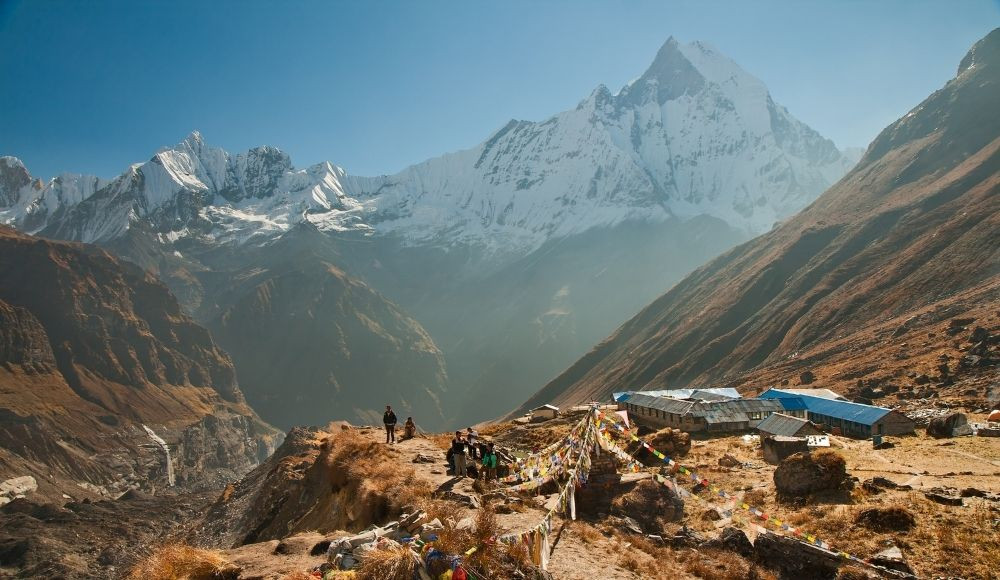
In addition to the natural deep dense forest along the trail, we will have astonishing views of the snow-capped mountains. When we eventually enter the Annapurna sanctuary and to the Annapurna Base Camp, we will find ourselves standing amidst the Himalayan peaks. The view of the base camp surroundings is just surreal and you will not believe that you are standing at that beautiful place.
Day 1: Arrive in Kathmandu, transfer to hotel, and welcome dinner (1350m)
Day 2: Drive from Kathmandu to Pokhara (915m): 7 hours
Day 3: Drive from Pokhara to Nayapul, then trek to Tikhedhunga (1577m): 5.5 hours
Day 4: Trek from Tikhedhunga to Ghorepani (2675m): 6 hours
Day 5: Trek to Poon Hill, back to Ghorepani and on to Tadapani (2590m): 7.5 hours
Day 6: Trek from Tadapani to Chomrong (2340m): 6 hours
Day 7: Trek from Chhomrong to Dovan (2505m): 5 hours
Day 8: Trek from Dovan to Deurali (3100m): 4 hours
Day 9: Trek from Deurali to Annapurna Base Camp (4130m): 4 hours
Day 10: Trek from Annapurna Base Camp to Dovan (2505m): 5 hours
Day 11: Trek from Dovan to Ghandruk (1940m): 7.5 hours
Day 12: Trek from Ghandruk to Nayapul, then drive back to Pokhara: 6 hours
Day 13: Drive from Pokhara to Kathmandu: 7 hours
Day 14: Free day and fly back
The Annapurna circuit consists of a long duration of walking and exploring the areas of Manang and Mustang. Annapurna Circuit Trek can be done either in short or in long both as with the road facilities are present there recently. Crossing uneven terrains, big Annapurna Mountains staying in ethnic villages, culture and language exchange with the locals and hiking the Hindu and Buddhist holy trails are major attractions of this trek.
The old classic trek used to be walking up the three weeks around four different regions in which two of them are in lower elevation with the country's dominant lush green subtropical valleys. And two of them are in high elevation; the new Annapurna circuit trek mostly goes on the trails of these higher altitude regions viz. Manang and Mustang.
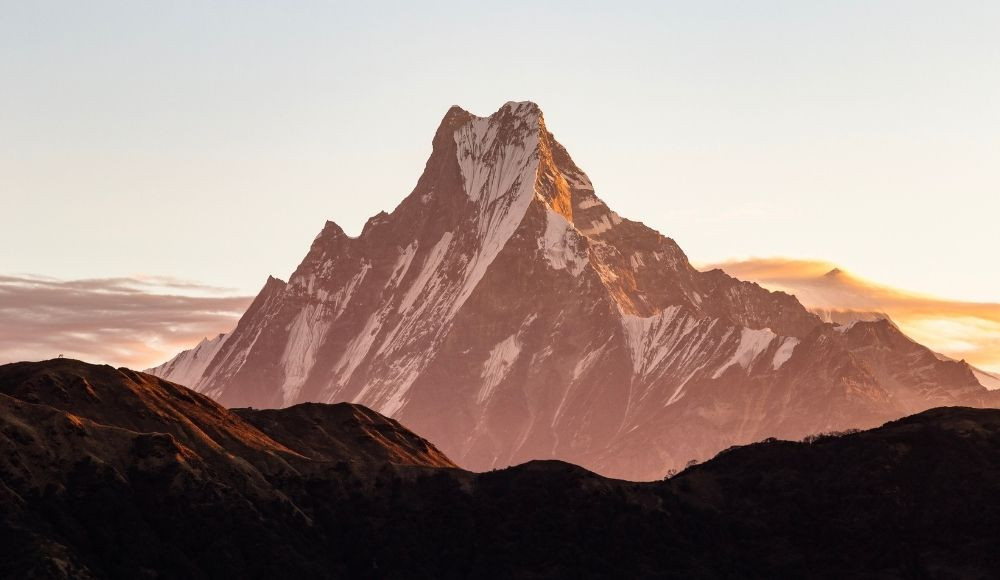
Manang and Mustang are at higher altitudes and are Tibetan Buddhists, mainly consisting of the Gurung tribe. Manaslu, Langtang, Annapurna I, II, III and IV, Gangapurna, Chulu east and west, Dhaulagiri, Tukuche peak and Nilgiri are dominant peaks scattered in this region. You can enjoy the close view of these mountains as it feels like walking at the base and climbing towards the top.
The trek starts with the drive from the country's capital Kathmandu towards the western side of Nepal. The drive will take you to the district headquarters of Manang, by this time we’ll leave the one region of the sub-tropical valley, Lamjung. The trek starts from Chame and it continues up to the Manang, Thorang la (the highest point on the trek and one of the highest passes of Nepal) and Mustang including Tilicho Lake in bonus.
Thorong la separates the districts Manang and Mustang and you’ll find a completely different landscape after crossing Thorong la. Mustang is also called the cold desert of Nepal where the wind is blowing continuously throughout the day. Our trek ends at Muktinath as you can choose the option of dive or flying from here. By the end of the trek, we will complete the round of the Annapurna Himalayas.
Day 1: Arrive in Kathmandu, transfer to hotel and welcome dinner (1350m)
Day 2: Drive Kathmandu to BesiSahar (823m) in 6-7 hours
Day 3 Trek from BesiSahar to Ngadi (860m) in 5 to 6 hours
Day 4: Trek from Ngadi to Jagat (1400m) in 5 hours
Day 5: Trek from Jagat to Dharapani (1943m) in 6 to 7 hours.
Day 6: Trek from Dharapani to Chame (2713m) in 5 hours
Day 7: Trek from Chame to Pisang (3185m) in 5 hours
Day 8: Trek from Pisang to Manang (3530m) in 8 hours
Day 9: Acclimatization day
Day 10: Trek from Manang to Ledar (4250m) in 4 hours
Day 11: Trek from Letdar to Thorong Phedi (4700m) in 3 hours
Day 12: Trek from Thorong Phedi to Thorong La (5415m) to Muktinath (3802m) in 8 hours.
Day 13: Drive to Jomsom and Fly from Jomsom to Pokhara (2560m)
Day 14: Drive from Pokhara to Kathmandu.
Day 15: Fly home.
The less trekked area on the lap of Annapurna is Khopra ridge. Khopra ridge trek is a short trek comprising villages, wildlife, panoramic mountain views and a range of landscapes from forest to high alpine grassland. The trek is a teahouse trek and you’ll stay at the teahouse run by the community of Myagdi district.
The mountains seen throughout this trek are, Mt. Dhaulagiri, Annapurna Fang, Annapurna south, Nilgiri, Gurja Himal, Tukuche peak, Dhampus peak, Dhaulagiri II/III/IV/V and Hiuchuli from the starting of trails.
We will start the trek from the famous Ghandruk village in the laps of Annapurnas from where you can enjoy the panoramic view of Annapurna south, Hiuchuli and Machhapuchhre peaks. First two days of the trek are the popular trail followed in the Annapurna region passing through the terrace fields, Rhododendron forests and Gurung community village.
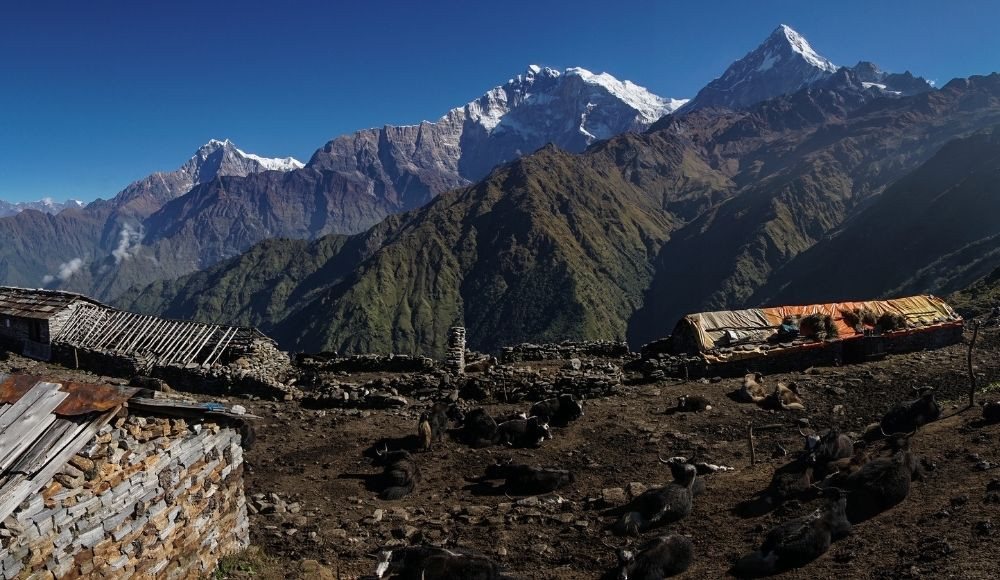
After leaving Tadapani we will follow the remote trail and stay at community lodges. The landscape totally changes as you reach the Bayali and big mountains start to appear even bigger. It is worth waking up early in the morning for a sunrise view across the panorama of mountains. While descending from Kopra Ridge we pass through alpine pastures, oak forest and rhododendrons to Swanta village where we stay in another community lodge before heading towards Ghorepani and Pokhara.
Due to the topography and location of Khopra, a sort of wilderness and adventure of thrilling walks can be tested on this trek. Khopra Trek is also the alternative trekking trail located away from the busier trail of Annapurna foothills. Thus the trek is with fewer tourists, quiet, peaceful, through Nature, Rhododendron Forest, majestic mountains, and diverse landscapes.
Day 1: Arrival in Kathmandu 1330m
Day 2: Fly/Drive from Kathmandu to Pokhara 820m/25minutes
Day 3: Drive to Ghandruk and trek from Ghandruk to Tadapani 2630m/3 hours
Day 4: Trek from Tadapani to Bayali Kharka 3420m/5 hours
Day 5: Trek from Bayali to Khopra Ridge 3026m/6 hours
Day 6: Trek from Khopra Ridge to Swanta 2214m/5 hours
Day 7: Trek from Swanta to Ghorepani 2860m/3 hours
Day 8: Trek from Ghorepani to Ulleri 1540m/5 hours and drive back to Pokhara
Mardi Himal base camp trek is one of the recently popular treks in Nepal. This trek is at the side of the Annapurna area. The trek takes you 4,500 meters to the base camp of Mardi Himal. Depending upon the fitness level and time duration the trek can be done either in a long or in a short time frame. Mt. Machhapuchhre, Annapurna south, Hiuchuli, Annapurna I, Gangapurna, Lamjung Himal are some of the major mountains seen during this trek. The trek is almost a teahouse trek and you’ll find a place to sleep and a place to eat throughout the trail.
Trek to Mardi Himal base camp can be started from various parts of the Kaski district of west Nepal. The major starting points are Kande, Dhampus, Landruk and Sidhing. Among these points, Kande is the most popular for trekkers to start the trek. The trek starts with the steep climb towards Australian camp, goes down to Pothana and again climbs back to Pitam Deurali before climbing to Forest camp. At forest camp, the trail starts from Landruk meets whereas at Pothana trail comes from Dhampus meets.
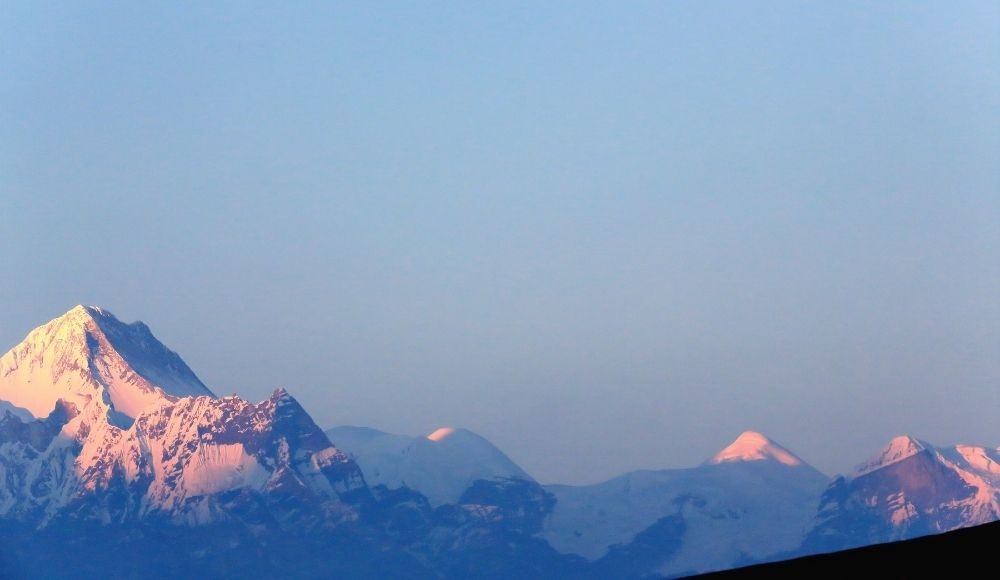
Trekkers have to pass through the dense Rhododendron forest before reaching Low camp. The vegetation completely changes after reaching the Middle camp where you’ll leave the tree line below and start walking at the steep cliffs of grasses. You’ll find the unique and unspoiled landscape of the Annapurna region before reaching Mardi Himal base camp via High camp.
The trek is the most unique and hidden part of the Annapurna region offering splendid views of the stunning Annapurna Himalaya. Sunrise, sunset, landscape, people, and culture are unique throughout the trail. Also, the trekkers seeking a homely environment can enjoy the Local home stay and tea garden.
Day 1: Drive to Kande and trek to forest camp (2100m)
Day 2: Forest camp to High camp (3200m)
Day 3: High camp to Mardi himal base camp back to high camp.
Day 4: High camp to Sidhing village.
Day 5: Trek to Lwang and drive back to Pokhara.
Day 6: Drive/fly from Pokhara to Kathmandu
Mohare hill is one of the hidden areas in the foothills of Annapurna. Laying at Myagdi district the trail is not very popular despite having amazing landscapes. You can enjoy the wonderful culture, nature, friendly locals and mesmerizing Annapurna range Himalaya. You can have a close view of Mt. Dhaulagiri, Annapurna south, Hiuchuli, Annapurna Fang, Nilgiri and many other sky-touching peaks. The trail lies just beside the Ghorepani-Poonhill trail so this can be the best alternative to experience the Annapurna region with very few people.
There are various routes depending upon the choice of the trekkers. The popular trail follows both Ghorepani-Poon Hill trail and then towards Mohare hill trek following Nangi and Banskharka to end the trek or vice versa. This trek is best suited for those enthusiasts’ travellers who have a short time to explore unlimited cultural and natural beauties of Nepal. Major highlights of this trek are, Magnificent views of Annapurna and Dhaulagiri mountain, trek through remote route with no altitude obscuration, Encounter monasteries, temples and stunning landscapes, Sunrise and Sunset View over Mohare Dada, Cultural learning (customs, religion, tradition) of Nepali People.
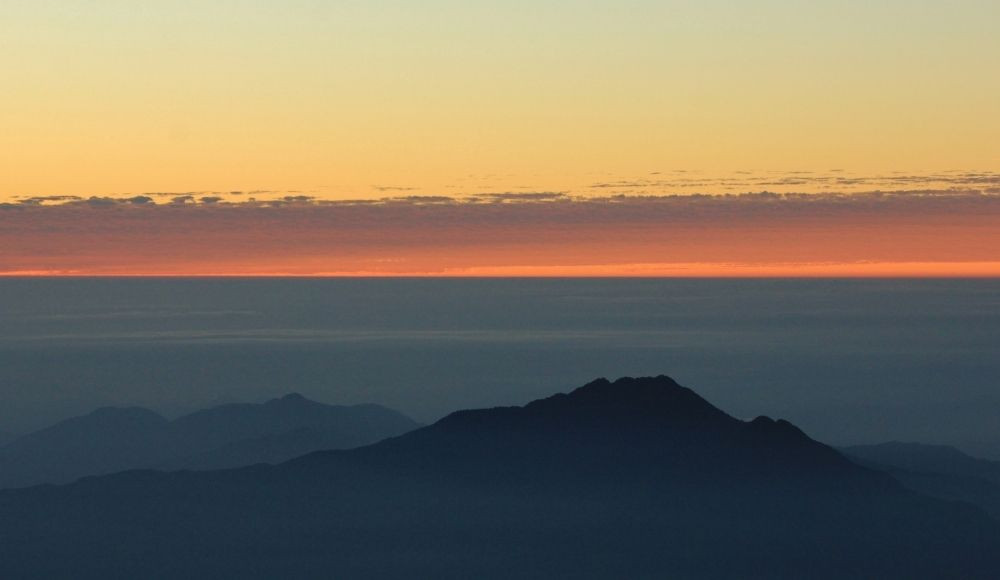
Mohare hill trek, also called community eco-trail as this trek is to promote sustainable eco-tourism of Nepal and to support local community projects that play a significant role in uplifting the lifestyle of rural people. Thus, you will stay in friendly homes, eat in community dining halls, meet local teachers and community organizers, and visit locally-run cottage industries to empower women. The community lodges have also adopted eco-friendly practices such as safe-drinking-water facilities and solar and micro-hydro electricity.
Day 1: Kathmandu Airport Arrival - (1,350m)
Day 2: Drive to Pokhara (7 hrs)
Day03: Drive to Galeshwor and trek to Bans Kharka (1,526 m) (3 hrs)
Day 4: Trek to Naangi (2,260 m) (7 hrs)
Day 5: Trek to Mohare Danda (3,320m) (7 hrs)
Day 6: Trek to Deurali (5 hrs)
Day 7: Trek to Ghandruk (1,940 m) (5 hrs)
Day 8: Trek to Nayapul and drive to Pokhara (4 hrs)
Day 9: Drive back to Kathmandu
Day10: Departure Day
Ghorepani Poon Hill is the second most popular view tower in the country just after Kalapatthar in Everest region. From Poon Hill you can enjoy the majestic peaks. The trail leading to Poonhill is not much difficult and accessible for the trekkers with any fitness. The trek is short and best for the family with children and elderly people too. The trek is a teahouse trek and there are plenty of teahouses that can accommodate you with the choice of yours. It is also called the luxurious trek as it has most of the facilities throughout the trek.
Gurung village, lush subtropical forests, Rhododendron forest, big mountains, wildlife, birds, waterlands, people and culture are major attractions of this trek. There are 22 types of Rhododendrons found in this area and a variety of flora and fauna. Major peaks seen from Poonhill are, Annapurna south, Hiuchuli, Machhapuchhre, Dhaulagiri, Nilgiri, Annapurna Fang, Tukuche, Gurja himal and Dhaulagiri II. The three mountains, Annapurna south, Hiuchuli and Machhapuchhre don’t leave the trekker throughout the trek and can be easily visible very near.
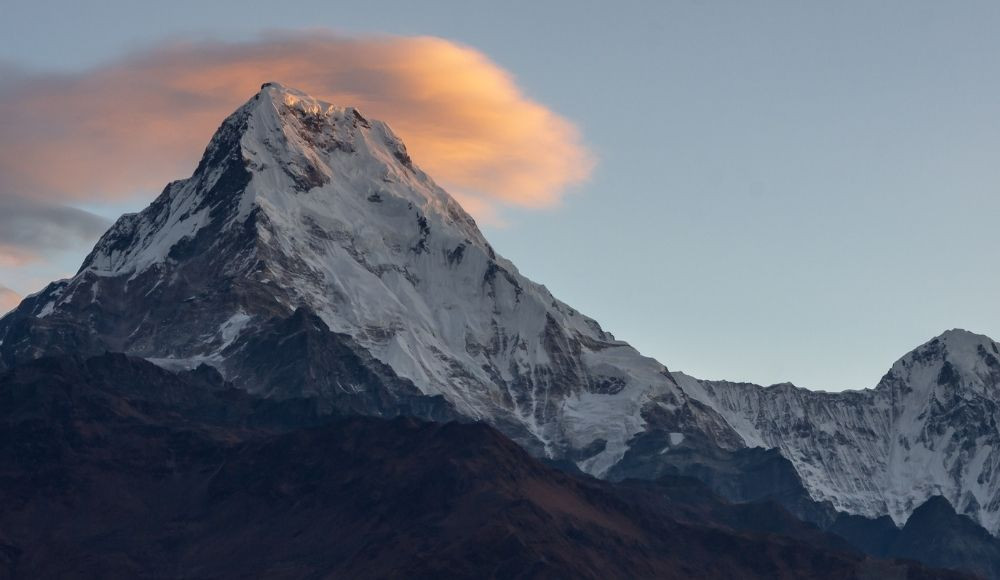
The trek starts at Nayapul (there is the option to drive also till ulleri) and continues towards Ulleri with climbing 3000 steps vertically. The trek then reaches the Ghorepani through the lush forest of Rhododendron. Ghorepani is the centre point for the trekkers climbing from various routes. From Ghorepani you’ll climb up the Poon hill in the early morning for sunrise in Annapurna and Dhaulagiri range. The trail then continues to the Tadapani and Ghandruk village where our trek ends. The trek lies in between the Annapurna circuit trek and Annapurna Base Camp trek so it also can be the gateway to two different areas of Annapurna.
Day 1: Fly/Drive from Kathmandu to Pokhara (8 hrs)
Day 2: Drive to Nayapul from Pokhara (1.5 hrs) and start trekking towards Tikhedhunga.
Day3: Trek from Tikhedhunga to Ghorepani via Ulleri (5-6 hrs)
Day4: Hike to Poonhill early morning and back to Ghorepani and continue the trek towards Tadapani. (6-7 hrs)
Day5: Trek from Tadapani to Ghandruk (3 hrs) and drive to Pokhara (3 hrs)
Day 6: Drive/Fly to Kathmandu from Pokhara (8 hrs)
The region bears different climatic zones. The tropic zone (600 m) to the arctic zone (5416 m). The annual rainfall is 5600mm to 400mm ranging from high to low. The temperature here is cold in the morning and warm during the day time.
I) Winter Season: (December-January-February)
The temperature ranges from( 7 to 12)°C on lower regions , (2 to 8)°C on the mid region. The temperature is negative on higher altitude.
II) Spring Season: (March-April-May)
The day temperature rises upto 10°C in lower regions whereas nights are colder. Above 4000 metres, the region gets freezing cold. One can enjoy crystal clear views during day time.
III) Summer Season: (June-July-August)
Rainfall coincides with the summer time in Nepal. The southern section is rainy. The minimum rainfall per month is 600-800 mm. But, the northern side remains dry as the region falls under the rain shadow. The rainfall is about 50mm in the areas like Jomsom, Marpha, Lower Mustang.
IV) Autumn Season: (September-October-November)
The day temperature below 2000 m is (18 to 22)°C in this season. Above 2000m to 4000m, the temperature ranges between (8 to 12)°C . The Annapurna region is quite warm in this season compared to other seasons. There are chances of cloudy days during these months. During the clear days, you can see gorgeous views of snow-capped mountains and hills.
In any season, one can visit the Annapurna region. But the best time to hike this region is in autumn (September to November). This is the time when the monsoon season ends. The heavy rains have cleared the air, making views of the Himalayas especially dazzling. It’s also generally a safe time, because the slopes aren’t too moist and slippery. And, finally, the temperature is just right, neither too hot nor too cold.
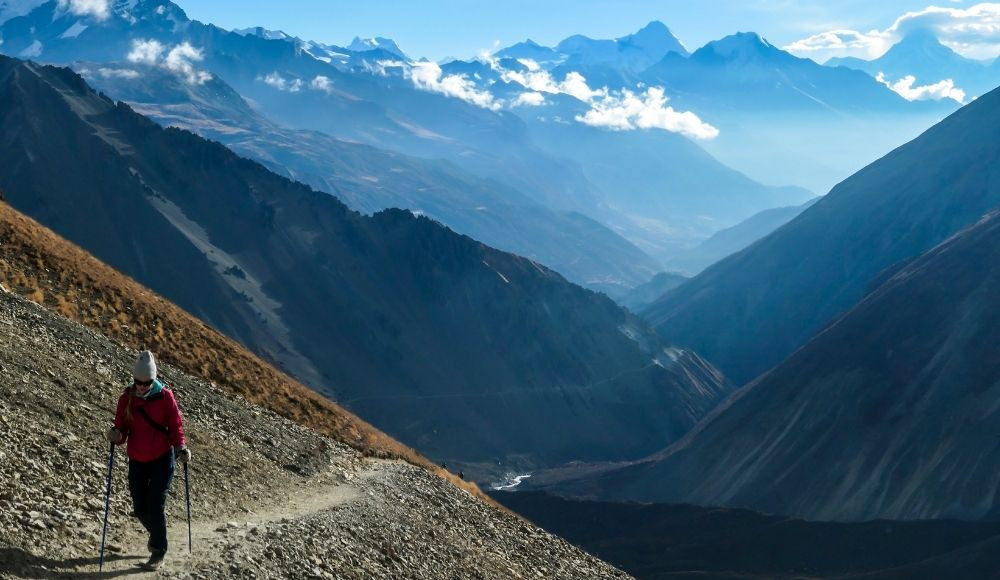
Early spring (March and April), before the monsoon season begins, are another good option. The rhododendrons and other flowers are in bloom, decorating the trails in spectacular colors. This is also the warmest time, which makes it favourable to travellers who don’t like the cold.
Tourism, over the years, has been firmly established as one of the most important sectors of the local economy. There are over 1,000 lodges, tea shops and hundreds of other subsidiary services. It helps thousands of trekkers, pilgrims and their support staff on their accommodation. Homestay and other accommodation facilities are easily available in this region.
There are three different options to reach this region. You can start trekking this region from Pokhara, Besisahar or Jomsom. 6-7 hours drive from Kathmandu will take you to pokhara. If you are starting from Pokhara, it takes around one and half hours to drive from Pokhara to reach Nayapul. From there you can explore the region on foot.
If you are going through Besisahar, you must take a drive from Kathmandu to Besisahar. Thereafter, you can take a private vehicle, reach Chame and start trekking this region.
Last but not the least, if Jomsom is your initial point, you must reach Pokhara. Then you can take a flight or drive there. From Jomsom, you will explore the region enrouting through Muktinath, and upper Mustang.